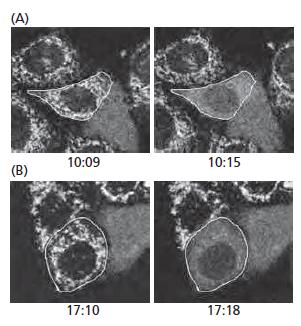When human cancer cells are exposed to ultraviolet (UV) light at 90 mJ/cm 2 , most of
Question:
When human cancer cells are exposed to ultraviolet (UV) light at 90 mJ/cm2, most of the cells undergo apoptosis within 24 hours. Release of cytochrome c from mitochondria can be detected as early as 6 hours after exposure of a population of cells to UV light, and it continues to increase for more than 10 hours thereafter. Does this mean that individual cells slowly release their cytochrome c over this time period? Or, alternatively, do individual cells release their cytochrome c rapidly but with different cells being triggered over the longer time period?
To answer this fundamental question, you have fused the gene for green fluorescent protein (GFP) to the gene for cytochrome c, so that you can observe the behavior of individual cells by confocal fluorescence microscopy. In cells that are expressing the cytochrome c–GFP fusion, fluorescence shows the punctate pattern typical of mitochondrial proteins. You then irradiate these cells with UV light and observe individual cells for changes in the punctate pattern. Two such cells (outlined in white) are shown in Figure Q18–2A and B. Release of cytochrome c–GFP is detected as a change from a punctate to a diffuse pattern of fluorescence. Times after UV exposure are indicated as hours:minutes below the individual panels. Which model for cytochrome c release do these observations support? Explain your reasoning.
Figure Q18-2

Step by Step Answer:

Molecular Biology Of The Cell
ISBN: 9780815344322
6th Edition
Authors: Bruce Alberts, Alexander D. Johnson, Julian Lewis, David Morgan, Martin Raff, Keith Roberts, Peter Walter





